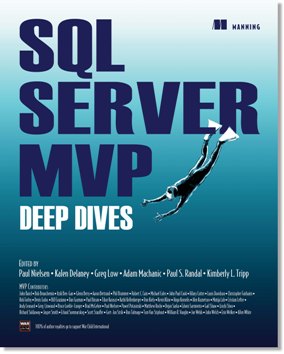 Well… it's finally been released and last week was the book launch. This book came together first as a goal by Paul Nielsen who was motivated by Steve Ballmer's request that MVPs "give back" even more and even outside of the direct technical community. Paul had the idea of a book – written for charity – and contributed to by MVPs. Well, here it is!
Well… it's finally been released and last week was the book launch. This book came together first as a goal by Paul Nielsen who was motivated by Steve Ballmer's request that MVPs "give back" even more and even outside of the direct technical community. Paul had the idea of a book – written for charity – and contributed to by MVPs. Well, here it is!
The book contains content from 53 MVPs with Paul Nielsen, Kalen Delaney, Greg Low, Adam Machanic, Paul S. Randal and I as editors. It was great fun going through all of the content and we're really happy that it's now available!
To purchase, click on the book (to the left) and purchase directly from Manning. When purchased through Manning a larger amount of the proceeds go to WarChild.
Finally, many of us were able to get together at PASS and "launch" the book. We gathered around a long table and people (if interested) had their copies signed. It was great fun! When it was all done – we took the group shot below.
Thanks for a great week (to all that were at PASS) and for great fun working on this title!
UPDATE November 16, 2009: After a few comments, I realized that a few people were tagged incorrectly in my facebook post of this photo and as a result, I had a few names switched around too. So, I just completely started over again and double-checked all the names… Also, I've added links to their websites so you can find out more information about the authors and editors of this title. Finally, I added that purchases should be made through the Manning website instead of other sites (so that more money goes to WarChild). And, finally, I added the entire chapter list with as many links as possible to everyone's websites. I'll keep this up-to-date as folks send me corrected lnks, etc. ENJOY!!
Present for the photo
- Front row starting from the left: Louis Davidson, Andy Leonard, Robert C. Cain, Paul Nielsen, Scott Stauffer, Don Kiely, Erin Welker, Kevin Edward Kline
- Second row starting from the left: Greg Low, Glenn Berry, Brad McGehee, Gail Shaw, Kalen Delaney, Erland Sommarskog, Allen White, Kimberly L. Tripp, Adam Machanic, Dejan Sarka, John Paul Cook
- Third row starting from the left: Joe Webb, Paul S. Randal

|
PART I
DATABASE DESIGN AND ARCHITECTURE
DATABASE DEVELOPMENT |
20. Why every SQL developer needs to have a tools database by Denis Gobo PART III
DATABASE ADMINISTRATION |
PART IV
PERFORMANCE TUNING AND OPTIMIZATION PART V
BI DEVELOPMENT |

9 thoughts on “SQL Server MVP Deep Dives (book for charity)”
Kimberly,
Thanks for including my name in the list of folks present for the photo, but, unfortunately, I’m not there. I’m not yet an MVP (maybe some day), so I wasn’t an author. I’m guessing you listed me instead of Andy Leonard, since I don’t see his name and he is in the picture between Louis and Robert McCain. There is a bit of resemblance with the glasses and goatee. Wish it was me!
I am glad you have put the names in your post..I couldn’t recognize one or two of the people. Feel also bad that I couldn’t make it to pass
Denis (chapter 8 and 20)
While Aaron was at the conference, I don’t think he’s made it to the photo. :-(
Michael, Isn’t Aaron next to McGehee (on the right)
I believe that’s Joe Webb. I must admit that Michael is right, and I am falsely credited for being in this photo… I was at the conference but unfortunately I wasn’t able to make this event (believe me, I am regretting this circumstance every day, and am very sad to have not been present).
As an aside, the best place to order the book is at http://www.sqlserverdeepdives.com/ … not meaning any ill-will toward Amazon, but when you order through the Manning site, the War Child organization gets the largest percentage of the proceeds. For me, if that means I spend an extra dollar or two, I’m okay with that. I believe you can use the code sqldeep40 to get 40% off the price quoted on the Manning site, which puts it right in line with all the other retailers (and again, with the added benefit that War Child *still* gets a larger percentage).
Arrgh! http://www.sqlservermvpdeepdives.com/ … that’s what I get for relying on my memory.
Thanks for everyone’s comments… I’ve completely updated this post AND added a TON of additional links for ALL authors and editors… please send me an email at Kimberly AT SQLskills DOT com if a link is incorrect and/or if you want a different link for your chapter/name.
THANKS SO MUCH for all of these comments and for everyone’s hard work on the title!
Cheers,
kt
Thanks for this nice post and photo, Kimberly. Now I’m feeling bad about not being there at PASS. Well, maybe next year! :-)
Hey there Pawel – We missed you for sure! I do hope you’ll make next year and/or that we make it back to Poland again for more fun!!
Cheers,
kt